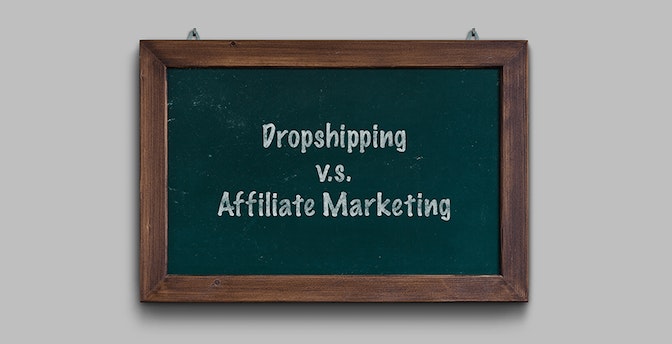Learning how to create an app by yourself isn’t easy.
There are so many ways to make an app – from hiring development companies and freelancers, to doing it yourself by coding from scratch or using app building software.
And even if you decide how to make an app, the work has only just begun. You still need to find the best app builders, decide who to hire, or work out which programming language to use.
Thankfully, it doesn’t have to be super hard. If you want to learn how to create an app, we can help.
Perhaps you want to build an app to make money, grow your business, or just for fun. Whatever the reason, this guide will help you realize how to make a mobile app from start to finish, step-by-step.
It’s worth noting that most of these steps involve strategizing and planning – not coding.
Don’t skip them – these steps are essential to successfully creating an app. Take it from the co-founder of Instagram,Kevin Systrom:“Instagram是一个应用程序,只花了八个星期to build and ship but was a product of over a year of work.”
Let’s get started.
How to Create an App?
How do you make an app? Before we run through the process of creating an app step-by-step, here’s a quick overview of how to make an app from start to finish:
- Define your objectives and reasons for creating an app.
- Come up with a great app idea.
- Define your app idea and who your app is for.
- Do some market research and make sure there’s a demand for your app idea.
- Choose a way to make an app, such as hiring a freelancing or using an app builder.
- Define your ‘minimum viable product’ – the first version of your app.
- Create an app wireframe to map out your app’s functionalities and features.
- Make an app mockup to plan the app’s design and user-interface.
- Compare your designs to competitor’s apps and tweak your plans if needed.
- Build an app with your method of choice.
- Publish your app on platforms likeApple’s App Store(screenshot below) andGoogle Play.
- Market your app to your target market to grow your user-base.
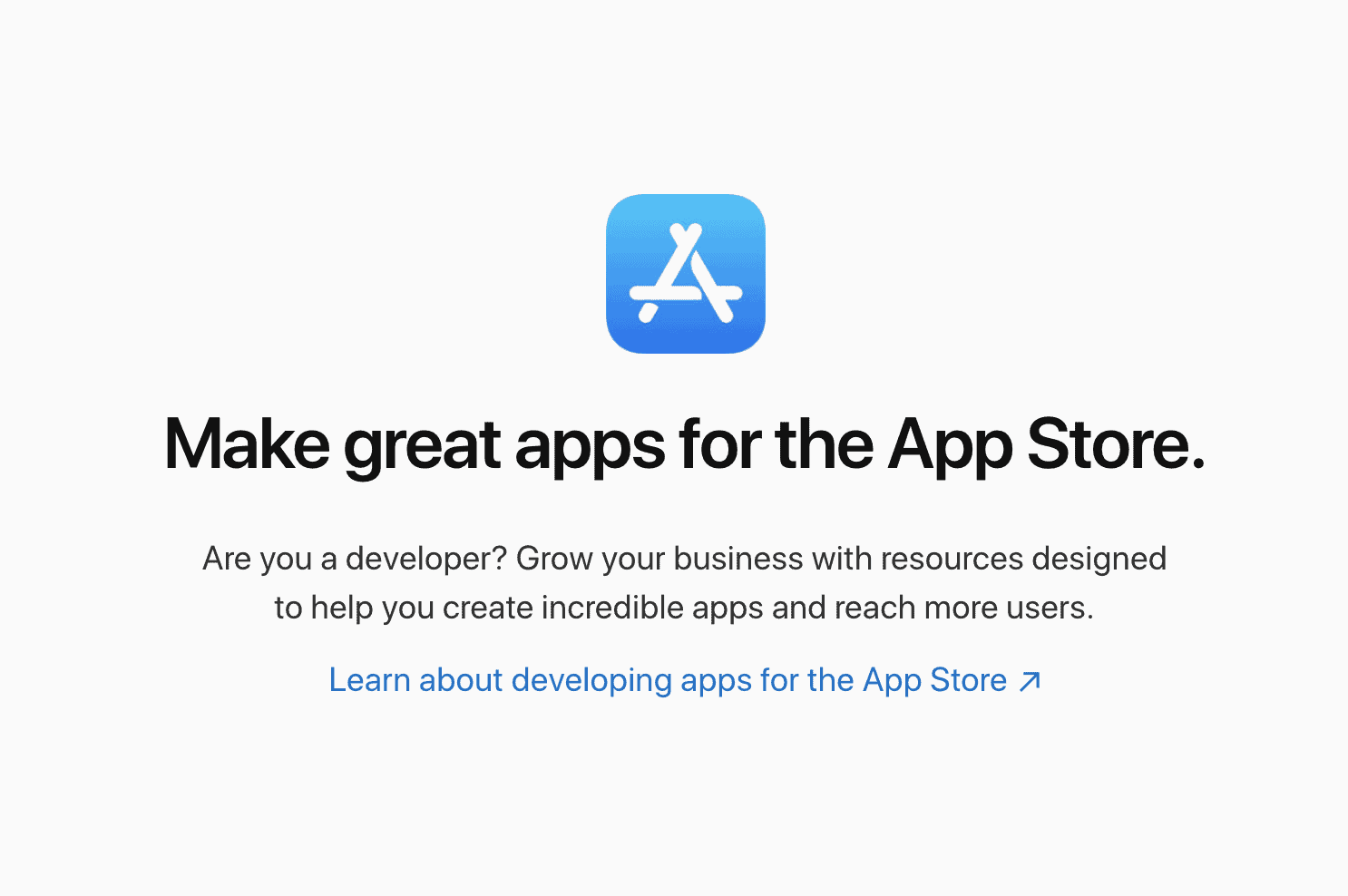
Step #1. Define Your Objectives
Before starting to learn exactly how to create an app, it’s helpful to define why you want to make an app in the first place.
Clarity is key.
You can use these objectives to guide everything you do, which will ensure you produce the desired result.
Try to clarify two things:
- Why do you want to create an app?
- How do you want your app to benefit users?
Think big picture, birds-eye-view – we’ll get into the nitty-gritty later on.
Why do you want to learn how to create an app?
Are you creating an app for fun? Do you want to create an app and turn it into a business? Do you want to make an app to grow an existing business?
Also, think about your approach.
Do you want to be creative and make a gaming app? Do you want to be practical and help people to boost their productivity?
Whatever your overarching goals are, write them down.
Next, try to clarify how you want your app to benefit users. Imagine someone asking you, “what’s in it for me?” Then, try to answer that question powerfully.
Are you going to entertain people? Will you help people be more productive? Are you going to make it easier for customers to purchase online?
Again, keep it general for now and write down your objectives.
Step #2. Come Up with a Great App Idea
Once you’ve clarified your objectives, you need to define your app idea.
If you already know what you want your app to do, feel free to skip to the next step. However, if you haven’t got a great app idea yet, this section will help.
Remember, the sky’s the limit when it comes to brainstorming app ideas. As the CEO of AppleTim Cook said:
“Prior to the App Store, the chances of that happening, of somebody really young forming a company and in a period of no time really becoming a global provider of a game or something else, it really didn’t happen. Now there are these success stories popping up everywhere.”
Here are four methods you can use to come up with a great app idea.
Method #1. Make an App to ‘Scratch Your Own Itch’
Instead of trying to figure out what other people want, ask yourself: “what problems do I have that an app could solve?”
If you experience a frustrating problem regularly, many other people are likely to feel the same.
Take Airbnb.
FoundersJoe Gebbia and Brian Cheskywere struggling to pay their rent in San Francisco. Then, a big design conference came to the city, and hotels were hard to come by. The solution? Gebbia and Chesky decided to charge people to sleep on air mattresses in their living room.
In another example, Zach Sims founded the popular learning site CodeAcademy because he found learning to code from books frustrating.Sims said, “It’s much easier to build for yourself. You know what works and what doesn’t.”
So, what problems do you come across regularly? How can you use an app to solve them?
For now, write down every problem you can think of – even if there’s an app that already exists to solve the same problem.
Method #2. Build an App That’s Better Than Existing Apps
There’s a lot ofapps out there: Google Play has 2.56 million apps, and Apple’s App Store has 1.84 million apps.
But don’t let this put you off – there isalwaysroom for improvement.
Have you ever used an app and thought, “I wish it would do X” or “I don’t like the way it does Y.” If so, this is the perfect seed for an app idea!
If you think an app isn’t as good as it could be, chances are, other people are thinking the same thing.
Plus, many app developers don’t bother to update and improve their apps. As a result, many apps become outdated, which leaves you plenty of opportunities to create better versions.
If you find an app worth improving, check the app’s ratings and reviews. Are there negative comments? Are people complaining about the same things? If so, you may have just found a great app idea!
Method #3. Put a Spin on a Popular App Idea
There are plenty of apps that you can put a new spin on to add value.
For example, there are countless fitness apps available. How can you stand out? One way is to tailor the concept of a fitness app to a niche audience.
For example, many surfers are keen to increase their fitness and strength to perform better when surfing. This is why the entrepreneur and surfer Cris Mills createdSurf Strength Coach(screenshot below), which provides workouts specifically designed for surfers.

What apps do you use regularly? Is there a way to tailor the app to a more specific audience?
Method #4. Create an App Mashup
Finally, if you’re still looking for a great app idea, use the mashup method.
The author of Steal Like an Artist,Austin Kleon, said, “Every new idea is just a mashup or a remix of one or more previous ideas.”
In other words, mashup many app ideas to create something new.
For example,Edison Mailcombined features from online shopping, task management, and travel apps to create a new email app that acts as a personal assistant.
You can use it to monitor social media updates, manage travel itineraries, track packages, and automate contact and email management.
Think about the apps you use regularly and the features you like best. Is there a way to combine these features?
Is there a way for you to mashup a popular app idea with something new?
Step #3. Define Your App Idea and Target Market
Once you’ve got an app idea, you need to crystallize what it does, who it’s for, and how it benefits users. Let’s start with what your app does.
Try to boil down the essence of your app into a short phrase.
For example, “this app helps users scan documents instantly using their smartphone camera, and then share them to any device,” or “this app helps customers book classes with their personal trainer, without having to call reception.”
Once you’re clear on your app’s primary purpose, it’s time to define who your app is for.
At this stage, it helps to think about demographicsandpsychographics. Here are some questions to help you define your target market:
- Demographic questions: How old is your target market? Where do they live? Are they students or professionals? How much money do they earn? Etc.
- Psychographic questions: What does your target market enjoy doing? What makes them laugh? How do they talk, dress, and act? What frustrates them?
Then, clarify the key benefits users will get by using the app. As the author and marketerOrvel Ray Wilson once said, “Customers buy for their reasons, not yours.”
Here are some questions that may help:
- What problem does your target market struggle with, and how does your app idea solve this problem?
- How are they currently attempting to solve this problem?
- How will your app impact users’ lives positively?
- What would your target market dislike about your app – and how can you avoid these things?
Finally, summarize what your app does, who it’s for, and what users stand to gain.
Step #4. Do Some Market Research and Validate Your App Idea
Market research is an essential part of creating an app.
You need to make sure that there’s a demand for your app and that your app offers additional value to what is already available in the market.
If you skip this step, you could waste countless hours making an app that no one wants, or that someone else has already made.
So, do some research and try to answer questions like:
- Are there apps similar to your app idea?
- How can you differentiate your app from these competitors?
- How much do your competitors charge? What’s their pricing model?
- Are the comments on competitor apps positive or negative?
- What do users like about these apps? What don’t they like?
You can also use free tools to help you determine whether people are actively searching for an app like yours.Google Trendswill show you how popular search terms are over time.
You can also use Google’sKeyword Plannerto see how many people search for different terms each month. The example below shows that the term “scanner app” receives 165,000 searches per month.
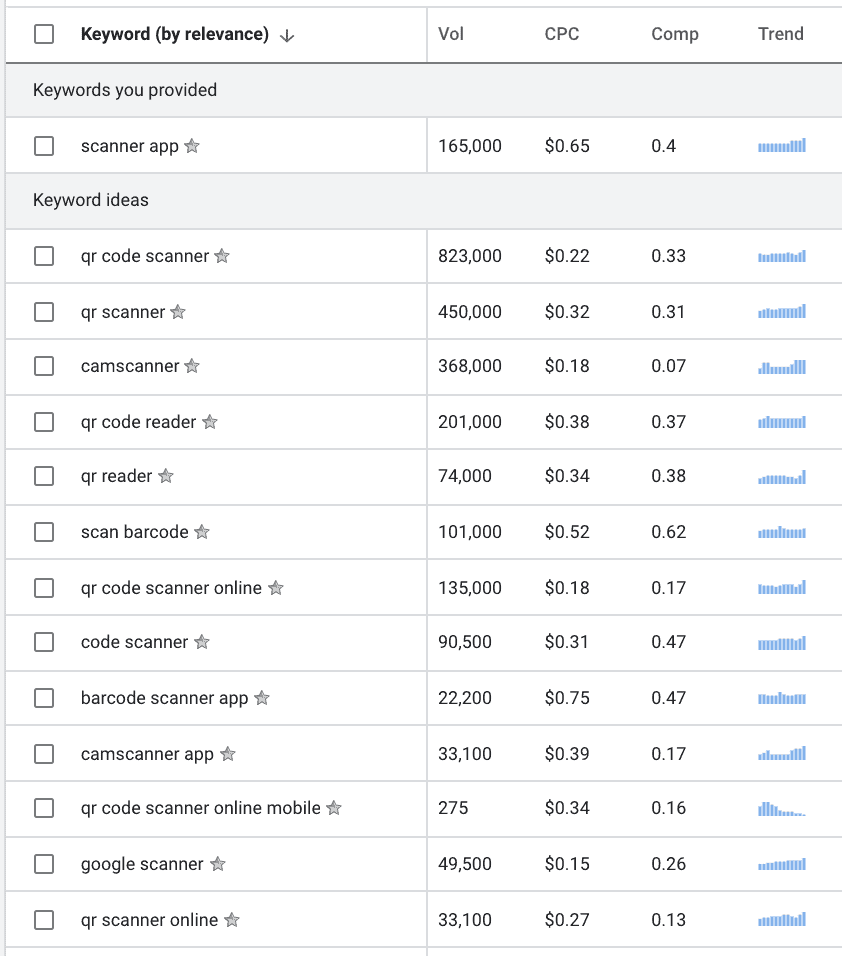
Finally, don’t forget to talk to people in your target market about your app idea. Do they seem genuinely interested and excited? Or are they just being polite?
In short, try to make sure that there’s a demand for your app idea. Then, clarify how you can differentiate your app from competitors.
Step #5. Choose How to Make Your Own App
At this point, you should have a solid foundation for your app. Now it’s time to choose how to create your own app. Here are six ways you can make an app.
1. Learn to Code and Build an App Yourself
I’ll cut to the chase: This is the most time-consuming and challenging option.
然而,如果你感兴趣的编程和want to develop an in-demand skill, learning how to create an app is a great way to hone your skills and gain valuable experience.
If you’re interested in learning how to build an app from scratch, you can use these sites to learn to code.
- Free Code Camp
- Code.org
- Khan Academy
- Code Academy(screenshot below)

2. Buy Customizable App Templates to Help You Create an App
It’s possible to purchase pre-written code that you can use as a foundation for your app. So, why reinvent the wheel?
Many of these templates come with readymade features, such as user accounts, payment gateways, and animations.
Typically, you can purchase app templates for a one time fee. Then, you (or a freelancer) can customize the template to your heart’s content.
You can find app templates for sale on websites likeCodeCanyon(also known as Envato Market),Creative Market, andCodester.
3. Hire a Freelancer to Make an App for You
You may want to consider hiring a freelance app developer if you:
- Aren’t interested in learning how to create an app from scratch
- Want to build a completely custom app, but you have a limited budget
- Are more interested in the business side of things
There are plenty of online platforms that you can use to hire freelance developers, such as:
4. Partner with a Programmer to Create an App
This is a good option if you would like a freelance developer to help you build an app, but you can’t afford to hire one.
Essentially, all you need to do is find a programmer who believes in your app idea and partner up to build an app business together.
However, this is easier said than done.
It can be tough to find someone willing to invest their time in a project with a stranger – unless you can show that you have a track record of launching successful software businesses.
Alternatively, you could partner up with a tech-savvy friend.
Famously, Apple founders Steve Jobs and Steve Wozniak started their relationship as neighborhood friends. ThenJobs convinced Wozniakto start a computer company with him. Jobs had the vision and marketing prowess, and Wozniak was a computing and software genius.
5. Hire a Development Company to Build an App
If you want to make an app for your business, and have a large marketing budget, you could hire a development company to build an app.
There are plenty of benefits to this option. For example, a development company will consult with you and then manage the project for you. In contrast, a freelance developer will expect you to manage and direct the project.
However, this route cancost you between $2,000 and $500,000, depending on the app you want to create and features you need. Plus, you’ll need to pay monthly maintenance costs.
6. Make an App with an App Builder
If you want to know how to create an app without coding, you’re in luck.
In 2020, there are plenty of app builders that make it easy to create an app. For a relatively small monthly fee, you can access a suite of tools, templates, and plugins to help you build an app in no time.
Let’s take a closer look at some of the best app builders available.
5 of the Best App Builders in 2020
An app builder makes the process of creating an app quick, inexpensive, and straightforward. Here are five of the best app builders to check out.
App Builder #1. Appy Pie
Appy Pie(screenshot above) claims to be the “quickest way to help you develop your app and start making money – without coding!”
This app builder services some top brands, such as Nike, The Home Depot, and Southwest Airlines. What’s more, it provides features that many app builders don’t. You can create a loyalty program, add maps and navigation, and make your app multilingual.
There’s also plenty of integrations with third-party tools and features. However, setting up these integrations can sometimes be challenging.
Plus, if youstart an ecommerce business with Shopify, you canuse Appy Pieto turn your online store into an app!
You can build an app for Google Play for $15 or $30 per month, depending on the features you need. To publish an app to Apple’s App Store, you’ll need to upgrade to the Platinum plan, which costs $48 per month.
App Builder #2. GoodBarber
GoodBarber(screenshot above) has plenty of stunning themes ready for you to customize.
This app builder also provides plenty of advanced features that are ready to drag and drop into your app design. You can use GoodBarber to create an app with push notifications, chat, auto-login, and more.
GoodBarber provides threepricing plans. It costs $25 per month to build a progressive web app, $48 per month to publish Android apps, and $96 per month to publish iOS apps.
App Builder #3. Swiftic
Swiftic(formerly known as Como DIY, screenshot above) claims to power thousands of apps around the world. It’s designed for small businesses, like retailers, bands, restaurants, and professional services.
It provides a range of app features, such as loyalty programs, user reviews, and appointment scheduling integrations. There’s also plenty of resources to help you build an app, plus hands-on support.
Swiftic’s pricingcurrently costs $39 per month, or $33 per month when you pay for a year upfront.
App Builder #4. Bizness Apps
Bizness Apps(screenshot above) is a premium app builder created for small businesses. The platform offers a ton of third-party integrations – including plenty of ways to capture new leads.
There are also some special features, such as the mortgage calculator, QR scanner, and food ordering system. It also offers app analytics, social media integrations, and payment gateways.
There are threepricing plans, depending on the features you need. Standard is $300 per month, Gold is $360 per month, and Platinum is $400 per month.
App Builder #5. Mobile Roadie
Mobile Roadie(screenshot above) is an app builder for enterprises. This company shows off its impressive list of clients on the website, including many million dollar companies.
它有一个数组的特性,比如优雅templates, popup promotions, and music players. It also has plenty of advanced features like geo-targeting, which you can use to deliver content to user segments.
Mobile Roadie doesn’t share its pricing on the website. However,online reviews suggestthe app builder costs between $149 and $799 per month.
Okay, let’s step back into our steps on how to make an app?
Step #6. Define Your Minimum Viable Product Objectives
Great apps often do just one thing, really well. For example:
- Ubergets people from A to B as efficiently as possible.
- Guitar Tuna helps people tune their guitars quickly and accurately.
And it’s good practice to design a ‘minimum viable product.’
A minimum viable product – also known as MVP – is a simple version of your app that focuses purely on what matters most, leaving all other features for future updates.
Creating an MVP speeds up the development phase so you can publish your app sooner. When you do this, you can get real-life feedback from users quicker. Then, you can use this feedback to release updates to tailor your app to your users’ needs and preferences.
Take it from Microsoft founderBill Gates: “Your most unhappy customers are your greatest source of learning.”
So, how can you create an MVP? In short: Design a version of your app that does just one thing very well.
To do this, think back to when you defined your app idea and target audience. What is the core problem you’re solving? What is the essence of your app? Make this the MVP.
Here are some questions to help you design an MVP:
- Are there any more features that you can leave out for now?
- Does your main feature meet your target market’s needs and desires?
- Will your app still deliver the intended benefits to users?
Plan out an app that is lean and as effective as possible.
Step #7. Create an App Wireframe to Plan Functionalities and Features
If you opt not to use an app builder or development company, you’ll need to create a wireframe for your app.
Why? If you hire a freelancer to help you create an app, you can use a wireframe to communicate your ideas to them. Alternatively, if you decide to create an app from scratch or with templates, you’ll need a wireframe to direct your efforts.
Okay, what is a wireframe?
A wireframe is a graphical representation of a product’s functions and features. It focuses on the practical aspects of building an app. This means that graphics, styling, and colors are left out for now.
Here’s an example of a recipe app wireframe fromMockPlus:
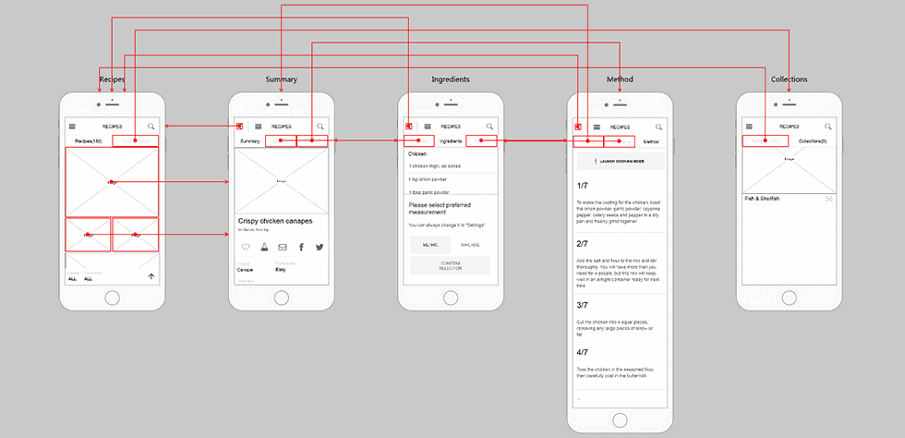
Think of your app’s wireframe as its skeleton – the bones holding the rest of the body together. It should clearly show the app’s basic layout and the flow between screens.
Depending on how much detail is needed, you can draw wireframes by hand.
Alternatively, you can use a dedicated tool to create an app wireframe, such as:
Step #8. Make an App Mockup
Like a wireframe, you’ll need to create an app mockup if you plan to build an app yourself or with a freelance developer.
A mockup is a rough sketch or graphic illustration of your app’s user interface, layout, and flow.
好的,但是如何从wirefra模型不同me? Simply put, a wireframe is concerned with the practical aspects of creating an app, whereas a mockup focuses on the visual and experiential parts of making an app.
When creating a mockup, choose colors, fonts, text, images, and branding. Here’s an example mockup examplefrom the app Manrim:
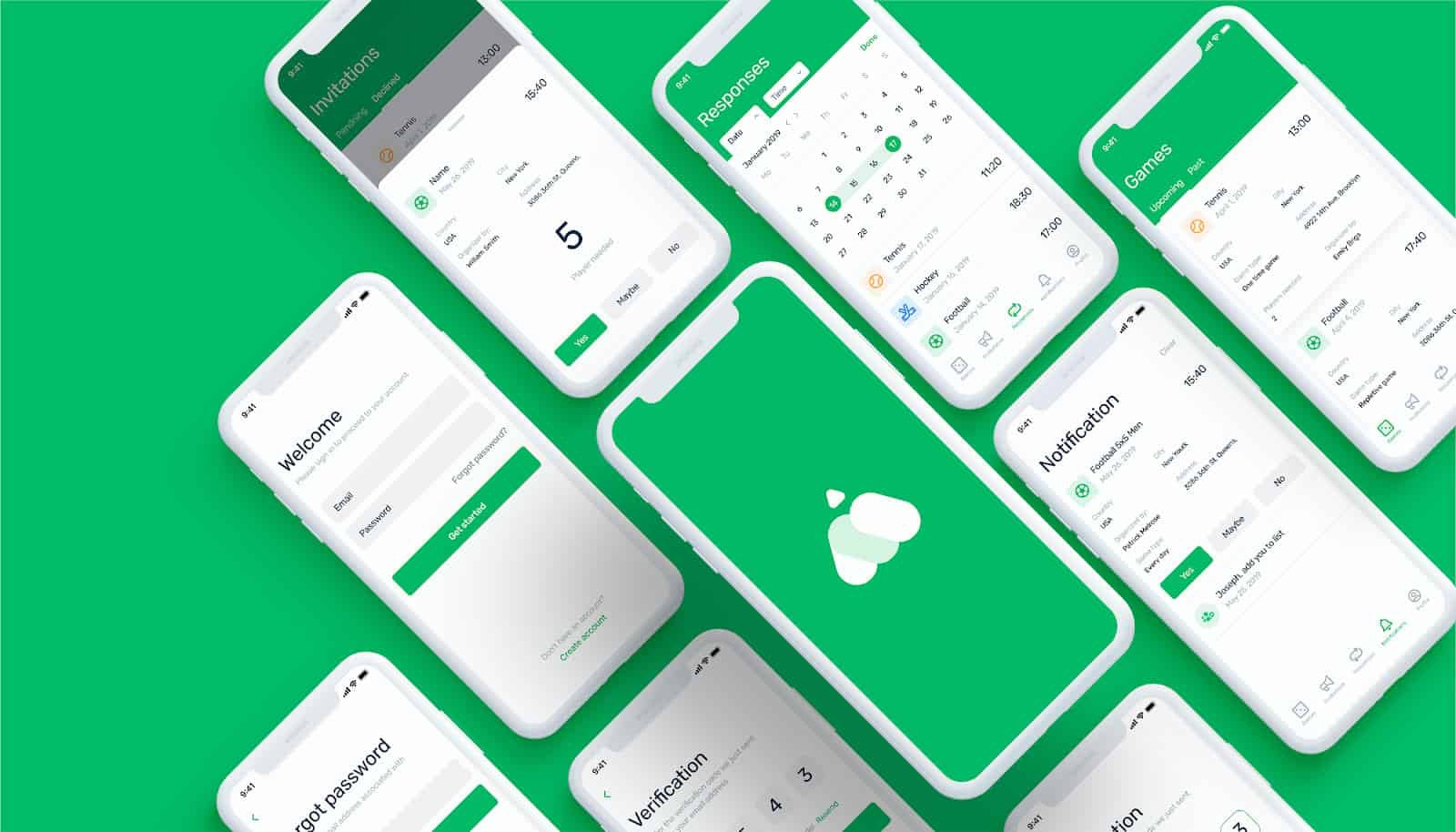
Again, you can do this by hand or by using a digital tool, such as:
Step #9. Compare Your App to Competitor’s Apps
Now that you’ve designed your app in detail, it’s time to pause and review your work.
It’s important to make sure your wireframe and mockups are polished before you start creating an app. Doing this can save you a lot of time and money down the road.
Tweaking and improving your designs now is a lot easier than changing an actual app.
A good way to improve your designs is to revisit your competitor’s apps to see how they’ve solved similar challenges.
Download competitor’s apps and compare them to your wireframe and mockups. Take a close look at how competitors have designed the layouts, features, and functionalities. Then, look for opportunities to improve your designs.
This process may also spark new ideas that you can use to improve your app designs.
Try to ensure that your app designs are the best they can be, but don’t get hung up on the competition. AsGinni Rometty, CEO of IBM, said, “You build your own strategy. You don’t define it by what another competitor is doing.”
Step #10. Make an App!
This is the fun part!
Whether you plan to hire a development company, build it yourself, or use an app builder, it’s the time to create an app!
Making an app can be frustrating at times. There could be mistakes, miscommunication, and trial and error.
So, take it as it comes and when in doubt, refer to your plans. Use your wireframes to help solve practical issues, and look back at your mockups to guide your designs.
It’s also wise to budget extra time and money in case things don’t work out as planned – which they rarely do!
Step #11. How to Publish an App
At this point, you’ve learned how to create an app, made an app, and are now ready to publish it to stores, like Google Play and the Apple App Store.
If you’ve used an app builder or development company to create an app, the service should help you with this step.
然而,如果你正在使用一个自由职业者或勒arning how to create an app yourself, you’ll need to upload it to stores manually.
Here are two official resources that’ll walk you through how to publish an app on:
- Android stores(such as Google Play)
- Apple app store
Step #12. How to Market an App
If you launch your app and don’t receive many – or any – downloads, don’t worry. You just need to promote your app to your target market.
Here are nine ways to market an app:
- Submit your app to platforms likeProduct HuntandBeta List.
- UseSEO tacticsto optimize the keywords in your app store listings – this will help more people find your app in search results.
- Make a websiteto promote your app and include stunning visuals and calls-to-action. Here’s a great example from the money management appSplitwise.
- Reach out to blogs that publish articles on the best apps in your industry and ask them to include your app. Make sure to highlight how adding your app to their recommendations will benefit their readers.
- 促进与en的社交媒体平台上的应用程序gaging videos, pictures, and text. Make sure to tag your posts with hashtags, such as #newapps, #googleplaystore, and #appstore.
- Harness the power ofinfluencer marketingby partnering with social media influencers in your niche to promote your app to their followers.
- Start a blogon your website and write useful, informative content for your target audience. Usecontent marketing best practicesto rank your articles on Google and drive traffic to your app.
- Talk to one person at a time. Great apps will grow through word of mouth. First, tell everyone you know. Then start networking in Facebook groups used by your target market. Strike up conversations and develop relationships. Then, when it’s appropriate, mention your app. Also, always make sure to follow the group’s rules.
- Consider paid advertising channels, such asGoogle Ads,Instagram Ads,LinkedIn Ads,Facebook Ads, and even advertising in the relevant App Stores.
It can take time to get consistent results from any marketing channel. So, persevere, be consistent in your efforts, and hone your marketing skills as you go.
Summary: How Do I Create an App?
If you want to know how to create an app, here’s a quick summary of the steps we’ve covered:
- Define your objectives
- Come up with an app idea
- Clarify what your app does, who it’s for, and what benefit it provides
- Make sure there’s a demand for your app idea
- Decide how to create an app – for example, hiring a development company or using an app builder
- Plan your minimum viable product
- Create an app wireframe
- Make an app mockup
- Get ideas from competitors and tweak your designs
- Build an app by your preferred method
- Publish your app on app stores
- Market your app to your target market
Learning how to create an app can be challenging, time-consuming, and sometimes, downright confusing. So, take it step-by-step and focus on one thing at a time. Good luck!






